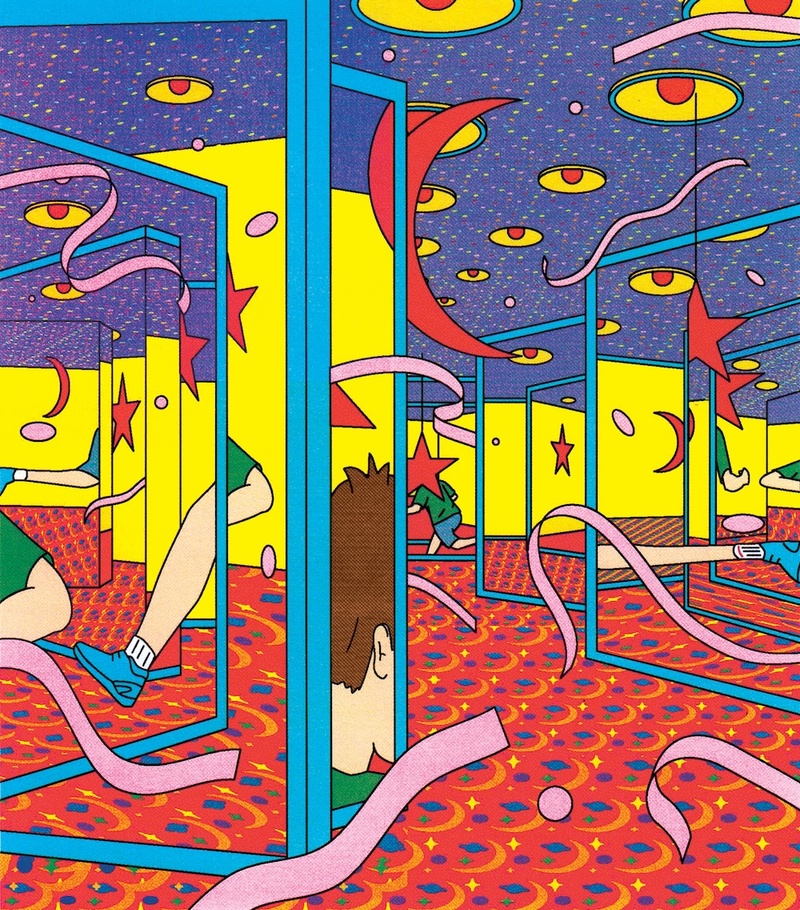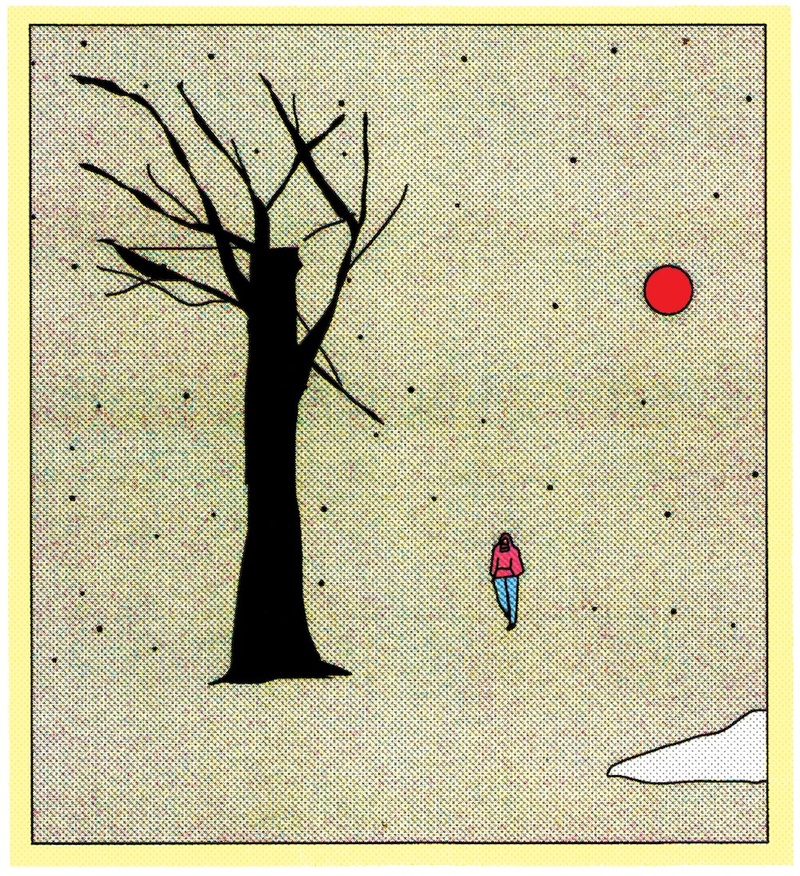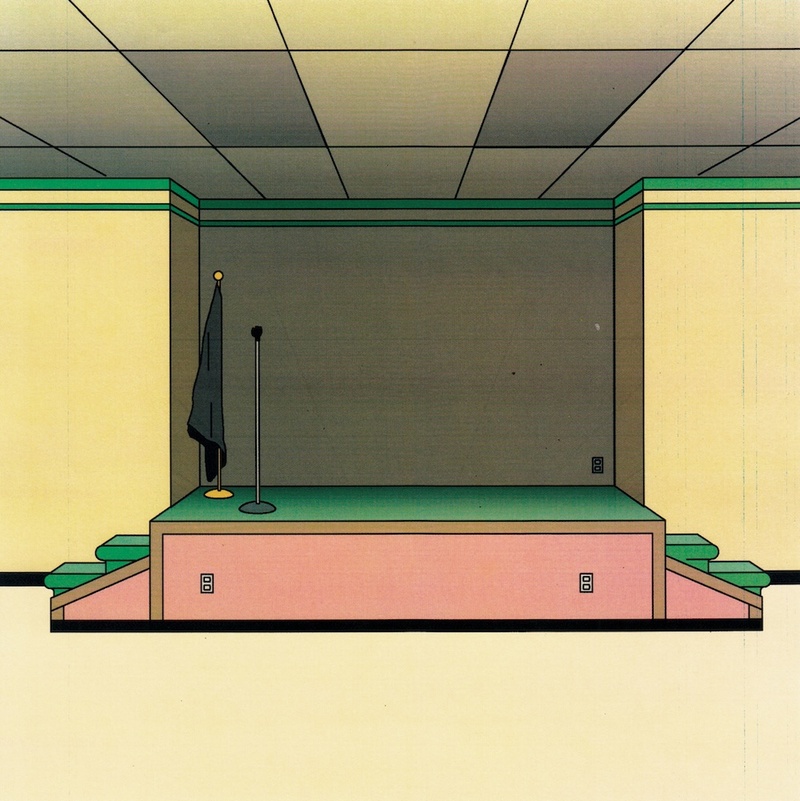You recently made an Instagram post about doing all your latest pieces in a giant empty hotel in the middle of Inner Mongolia. I’d be interested in learning about how that experience came about, and how it went.
My wife is Chinese. She’s from Inner Mongolia. We met here in Baltimore at school. She hasn’t been home to see her family in maybe four or five years because of the pandemic, so this year we came back. Her family lives in a really rural isolated part of Inner Mongolia. It’s kind of like a mountainous desert region. Her family is divorced, and there’s a lot of family drama and it’s really awkward, so I didn’t want to stay with them. I got this super cheap hotel down the road, but my wife stayed with her mom the whole time. So I was just there by myself in this completely empty hotel with no visitors at all for like two months straight. It was really weird.
I thought it would be good for creativity, because I’ve been kind of having a creative block lately. I thought it would be good to get there and work every day, and I got nothing done. I couldn’t work at all there.
So isolation didn’t end up being a sort of creative—
No. It didn’t happen for me. I mean, I had some good ideas come in, and I did a lot of professional work. I wanted to do some bigger projects like reworking my classes and stuff like that, and I just couldn’t have any… It was like I had too much time, so all I did was watch TV and walk around.
I think that’ll be interesting for artists who maybe dream about working in that type of isolation to learn.
It might help some people, yeah. But it didn’t work for me, so I don’t know.
I want to talk about the business side of illustration. I’ve heard you talk about the importance of illustrators focusing on personal projects to grow their careers. Can you talk more about that?
I think that advice is really good for students or people who are just graduating and trying to start a career. I see students get out of school and build their portfolio with fake professional projects. They’ll assign themselves an editorial illustration to do, or they’ll do fan art for something. In my experience, and seeing that happen, I feel like that doesn’t work at all for getting jobs and getting work. The things that art directors respond to, and make an art director interested in commissioning someone, is personality, and applying that personality to have a unique personal voice. In this illustration environment, a lot of the work can look really similar. A lot of people are using the same tools and the same brushes, and drawing characters and stuff in the same way. So whatever you can do to break out of that and separate yourself, I think is the way to get work.
What’s the ideal art director/illustrator relationship? How would you advise illustrators best communicate with their art directors?
I try to teach this in my class. I mean, I’ve never been an art director, so I don’t know what’s going on behind the scenes back there. For me, an ideal art director is someone who recognizes what I do best, and then just says, “Okay. Just go do it, and I’m not going to say anything. I’m just going to let you do your thing.” I feel like, for me, when I get kind of micromanaged, the work really suffers. Then the work that comes out is just so boring, and I don’t care about it, when it’s that kind of micromanaged environment. But I teach a lot of professionalism, like how to send an email, like a cold call email to an art director that includes a brief message, your artwork. Make sure to research them, make sure your work fits with them, be prompt and on time, and give sketches on the deadlines. All those soft skills are really important, especially for a job that’s so online, where you never meet anyone.
You’re represented by an agency now, but when you were first starting out, how did you find clients? Did you use any tools or documents to keep track of client relationships, rates, things like that?
Yeah, it’s really hard to get work now. There’s so much good talent in the field. It’s so hard to get noticed, especially since social media in 2023 works differently than it did when I started working, and that was less than ten years ago. I did a lot of cold call emails, and I sent postcards of my work to art directors. That stuff never really worked for me. I mean, I know you have to be persistent and keep doing it, so I always tell my students to do it. But I think all the jobs I started getting before I was represented were through Tumblr, which at the time was really popular.
So I had my work out on Tumblr, and art directors saw me on there and just commissioned me, because they saw the work happening on Tumblr. But now, there’s not really a platform for just sharing an image on its own. Instagram totally adjusted its algorithm or whatever. My engagement has fallen dramatically. Everything has to be a video now, for some reason. So I don’t know. I don’t know how you’d go about building that today, like TikTok maybe? But I don’t know if art directors are on TikTok to notice it.
You mentioned it’s a different social media landscape now than it was ten years ago. There’s also other more recent concerns like AI. Are you concerned about AI? Is it something that you talk about with other illustrators?
We do talk about it. I think my consensus from everyone I talk to is we’re not really worried about it. I feel like it’s not that good. Right? On a very surface level, first reaction you’re like, “Wow, that’s cool that a computer can generate a picture of a dinosaur with a gun on it, or whatever.” But when you actually look at the image, there’s so many parts that are blurry and not drawn well. Even if they fix those generators, I think what an illustrator is commissioned for is their ideas and their personality. You commission an illustrator for their way of communicating visually, and not everyone can do it. It’s a skill that can be learned. I think what AI will replace is stock photography, stock illustration, whoever’s doing really crappy mobile game ads, the AI’s going to replace that. I don’t think it’s going to replace actual good illustrators that have a voice and a soul.
Speaking of voice and style, I think the question “how did you develop your style” is a hard one. But is there a moment or a piece where things kind of clicked, and what kind of work did you have to put in to get to that place?
It took a really, really long time. This is something I struggled with when I was a student, and even through grad school a little bit, where I just didn’t have any personality with my work at the time. All I knew how to do was draw academic stuff, like still lifes and figure drawings and stuff like that. It wasn’t until I got to grad school and I could experiment a little bit more with processes that things started to come out. I really like to draw with Illustrator. It just clicked with me, the program. And I had a workshop led by Mikey Burton, an artist who mentioned that he uses a printer to get textures on his work.
I thought, okay, maybe I could experiment with that, because we had a bunch of different printers there. So I was experimenting a lot my first year in grad school on how to do a digital drawing, print it, blow it up, scan it back in and get all that texture. And eventually it kind of came together. It came together in the end of my first year in grad school, where my professor saw some of the work I was doing with really distorted textures and really glitchy stuff. She said, “It’s good.” Just that little encouragement really helped to solidify it, and then it just kind of evolved out of there slowly.
Now you’re kind of known for a certain style, like the bright colors and those textured backgrounds that you just mentioned. Do you ever feel trapped by that style?
No. A little bit. I mean, I’ve been thinking about this a lot in the past year or so, where I feel just kind of bored. I feel like I got it. I figured that style out. I’m still changing stuff and trying new things, but on a much smaller scale than I was before. So I had been thinking lately that it’s time to start something new, like a new process. It’s good to have a workflow down that you can approach professional projects with and just get them done, because the deadlines are so tight. I don’t have time to experiment fully with every piece. So it’s good to have that in place, but now, again, I just don’t really know what to do. I’m kind of bored, and I want to experiment with some new materials or something.
I miss that feeling of being new to something, and not knowing what to do, and trying stuff that maybe doesn’t work. And it’s fine, because you never show it to anyone. I’m trying to get back into that head space a little bit.
How do you get into that head space? Is it just through personal project work experimentation, or do you change your situation or environment or something?
I think I need to change the media that I work. I know Illustrator and Photoshop really well now. I teach them, I use them like eight hours a day, every day. So I’m not questioning anything, or having a block over how do I achieve this effect, or something like that. I need to do something where I don’t know how to do it, like experiment with a completely different process that I’ve never tried before. A couple of years ago, I was teaching myself Blender, and I felt that same way. I was like, “Oh, I don’t know how to do this. I’m experimenting. It’s not going that well, but stuff is coming out. It’s kind of exciting.” So I need to teach myself a new program, or a new tool or something like that.
You just released a new book, Curses. I like that you still make time to do personal projects, even though you now have a lot of client work with tight turnarounds. Do you break up your day in any way to divide time between client work and personal work? I know you also teach, so that probably factors into your schedule too.
Yeah, it’s a lot harder now with a heavier teaching load and more client work to go on. I probably should have a more structured, designated personal work time, but I usually just try to get everything with deadlines done as soon as I can, so I don’t forget them or miss them. Then any time that’s left over, I can work on personal projects, or just kind of sketch or read a book or something. Or not do anything, which I’ve been doing more of.
I’m curious about your process for collecting references. I know for Internet Crusader you used the Wayback Machine. In your five things, you recommended using your phone’s camera roll as inspiration. Do you actively go out in the world to find inspiration and references and take photos?
I would say not actively, but I think whenever I go out, I’m always thinking of and looking for stuff that could come into my work. I’ll just take a walk around the city, and I’ll see a concrete barrier and think that looks really cool. I’ll just take a photo of it, and I’ll forget about it for like five years. Then I’ll be scrolling through my camera roll and be like, “Oh, that’s cool. I can just draw that.” Sometimes I will go to a place that I just think is cool, and take photos of something.
What’s an example of a place like that for you?
Well, I really like to travel, so wherever I go, I’m taking those kinds of photos. What I specifically am super interested in, and I always take photos of and I look for, is text, like text in the world. Signs and packaging, or a handwritten note that’s posted on the bathroom door or something. Lately I’ve been interested in printing, and how different cultures print stuff. Even if I just go to the Chinese supermarket near me, their packaging is so different. There’s a fully photographic printed photo of a woman on the package, and it’s really bitmapped and grainy. That is really fascinating to me, so I’ll take a lot of photos of that kind of thing. Or just an interesting character in Chinese or Russian text, something like that.
Is there any other advice that you give young or more beginning artists?
I mean, I guess I said this already, but it’s so important to trust your instinct and do what’s fun for you. So many students just think that they’re in school and they have to get an A, and they have to make their illustration look good. But the best illustration and the most successful popular illustrators are doing stuff that’s totally weird. It’s not really a beautiful Procreate drawing or something. There’s this instinct in students, and I definitely had this myself, where it’s like, I’m trying to fight my base instincts as an artist. I hear this a lot from students where it’s like, “I draw people too much. I’m trying to get away from that.” But instead of saying that, I think it’s so important to run headfirst into your natural tendencies as an artist.
George Wylesol recommends:
Playing Silent Hill 2 at night
Taking a walk through a vast network of tunnels
Using your phone’s camera roll as inspiration
Eating Sichuan food in the morning
When you’re facing a creative block, draw the same thing in 100 different ways as fast as possible, it will really help break you out of a rut!!!
This content originally appeared on The Creative Independent and was authored by Kristen Felicetti.




